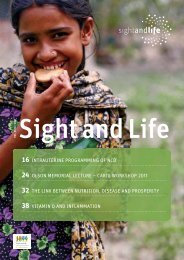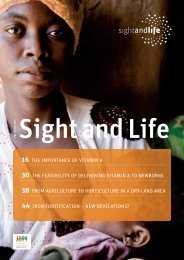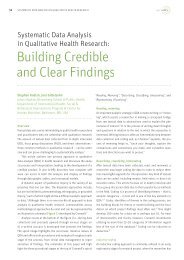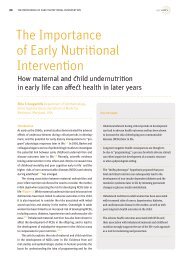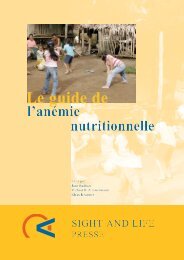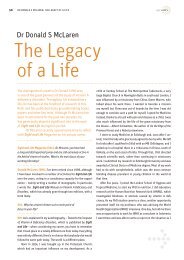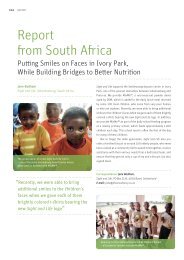Newsletter 02 2006.pdf - Sight and Life
Newsletter 02 2006.pdf - Sight and Life
Newsletter 02 2006.pdf - Sight and Life
You also want an ePaper? Increase the reach of your titles
YUMPU automatically turns print PDFs into web optimized ePapers that Google loves.
NEWSLETTER 2/2006<br />
11<br />
SIGHT AND LIFE<br />
EV McCollum Paul Karrer Otto Isler (left)<br />
function of vitamin A outside the<br />
visual cycle was still speculative<br />
(11). Analytical methods for quantitative<br />
analysis existed for both<br />
the preformed vitamin <strong>and</strong> for<br />
provitamin carotenoids, but these<br />
methods were often tedious, difficult<br />
to st<strong>and</strong>ardize, <strong>and</strong> frequently<br />
used toxic chemicals that failed<br />
to provide reproducible results in<br />
many laboratories (12–14). There<br />
were no large-scale intervention<br />
programs to combat vitamin A<br />
deficiency <strong>and</strong> even at the local<br />
level within hospitals there was<br />
little appreciation of how to treat<br />
or prevent the deficiency, which<br />
often accompanied proteinenergy<br />
malnutrition (PEM). And<br />
notably, there was very little political<br />
interest or will to eliminate<br />
vitamin A deficiency.<br />
I saw my first cases of xerophthalmia<br />
in 1961, more than four<br />
decades ago, while conducting<br />
doctoral research among refugee<br />
children in what was then Jerusalem,<br />
Jordan. I was midway<br />
through studies at Columbia<br />
University Institute of Nutrition<br />
Sciences, later renamed the Institute<br />
of Human Nutrition (IHN).<br />
I went there in 1959 because of<br />
a deep concern for problems of<br />
childhood malnutrition in the developing<br />
world <strong>and</strong> the desire to<br />
become professionally involved<br />
in seeking appropriate solutions.<br />
The Institute had a newly created<br />
program led by William Henry<br />
Sebrell, one of the pioneer nutritionists<br />
of the 20th century. The<br />
Institute’s objective was to train<br />
students to analyze, underst<strong>and</strong><br />
<strong>and</strong> seek solutions to malnutrition<br />
in the developing world in a holistic<br />
context (15). My academic<br />
training within this environment<br />
<strong>and</strong> the opportunity to do my<br />
thesis research in an international<br />
setting among malnourished children<br />
set the tone for the rest of<br />
my professional career.<br />
2006: Where are we<br />
today – after 4½<br />
decades?<br />
Prevalence<br />
No doubt, we have a greater<br />
appreciation of the magnitude<br />
of the global problem <strong>and</strong> the<br />
epidemiological factors, in addition<br />
to diet, that contribute to<br />
its existence. The Micronutrient<br />
Report published in 2001(16)<br />
placed the magnitude of the<br />
problem among preschool-aged<br />
children at 75 – 140 million; earlier<br />
estimates by the WHO placed the<br />
prevalence as high as 230 million<br />
(17). These prevalence data are<br />
based on clinical eye signs <strong>and</strong>/or<br />
low blood vitamin A levels from a<br />
database that is far from representative<br />
<strong>and</strong> firm. Nonetheless,<br />
The Micronutrient Report also<br />
noted a trend toward improvement<br />
since 1980 in most regions<br />
of the world, particularly since<br />
1990, a period when large-scale<br />
periodic vitamin A distribution programs<br />
were exp<strong>and</strong>ing. Indeed,<br />
on the public health level, intervention<br />
by periodic distribution<br />
of high-dose vitamin A supplements<br />
now covers an estimated<br />
70% of preschool-aged children<br />
in 40 countries with at least one<br />
dose of vitamin A annually, <strong>and</strong><br />
about 1/3 of these 40 countries<br />
have achieved 70% coverage<br />
with the required two doses (18).<br />
However, now we know that the<br />
problem extends beyond the preschool<br />
years to pregnant women<br />
whose health <strong>and</strong> survival also are<br />
compromised in countries where<br />
deficiency is common (19). The<br />
magnitude of deficiency among<br />
pregnant women, however, is<br />
largely unknown <strong>and</strong> there are few<br />
targeted prevention programs in<br />
effect that reach these vulnerable<br />
women.<br />
Metabolism <strong>and</strong> methods<br />
Knowledge of the metabolism of<br />
vitamin A <strong>and</strong> carotenoids has<br />
advanced dramatically since<br />
1960. The active forms <strong>and</strong> functions<br />
of vitamin A are established:<br />
retinol in the visual system <strong>and</strong><br />
retinoic acid in normal growth<br />
<strong>and</strong> development by modulation<br />
of gene actions. And new knowledge<br />
of non-provitamin A roles of<br />
carotenoids in the moderation of<br />
degenerative diseases is evolving<br />
as definitive analytical techniques<br />
allow for tracing the metabolism<br />
of individual carotenoids. Quantitative<br />
analytical methods for<br />
retinoids are well advanced (20)<br />
<strong>and</strong> this has contributed to a<br />
variety of new field assessment<br />
methods, including a more objective<br />
<strong>and</strong> reproducible meas-







